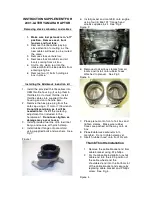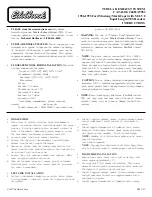
Page 3
Lotus Service Notes
Section DJ
DJ.1 - GENERAL DESCRIPTION
The independent rear suspension comprises, on each side of the car, upper and lower forged aluminium
wishbones, a forged steel toe control link, a concentric coil spring/telescopic damper unit, and a tubular steel
anti-roll bar, all being attached to the galvanised steel rear subframe. A forged steel hub carrier, provides a
mounting for the hub bearing unit to which the 5-bolt road wheel and brake disc are attached, and also carries
bosses for the cross-axis fixing bolts for the brake calliper.
The primary, vehicle weight bearing, lower wishbone, is widely based and substantially cross braced, and
incorporates separate double shear mounting points for the hub carrier and damper lower eye, and a single lug
for the anti-roll bar drop link. The outboard end of the wishbone is through bolted to a spherical joint pressed
into the lower eye of the hub carrier. The upper wishbone is of simple 'A' form, and houses a replaceable
through-bolted spherical joint at its outboard end to connect to the hub carrier. The inboard ends of both upper
and lower wishbones use replaceable bonded rubber pivot bushes for maintenance free articulation, with the
bush compliance profile tuned to provide the vehicle with accurate and responsive dynamic characteristics. The
toe control link is a two part steel forging incorporating an adjustment turnbuckle, and by connecting a rearward
extension on the hub carrier to the chassis subframe, a 'toe-in on compression' bump steer characteristic is
produced. Through bolted spherical joints are used in each end of the link, and the threaded turnbuckle allows
for adjustment of rear wheel alignment. An eccentric cam incorporated at the rear pivot point for the lower
wishbone, provides a means of camber adjustment.
The bottom of the Bilstein monotube telescopic damper fixes to the lower wishbone in a double shear
arrangement, with the damper top end secured to the subframe via a steel bracket bolted inside the subframe
tower. The damper uses a rubber bush in the top eye for noise suppression, and a through bolted spherical
steel joint in the lower eye for optimum dynamic response, and is orientated with the damper rod uppermost.
The dual rate, concentric coil spring abuts against a lower seat fixed to the damper body, and an upper seat
secured to the damper top eye, but also bolted to the subframe, thus relieving the damper top bush of vehicle
weight to the benefit of noise and ride refinement. The close coiled end of the spring is mounted lowermost,
on the damper body.
A 21mm o.d. tubular steel anti-roll bar is mounted in rubber bushes to the underside of the subframe
rearward of the axle line, and curves over each toe-link before connecting to the lower wishbone rear leg via
a short ball jointed drop link.
The hub bearing unit, which is common to all four wheels, is fixed to the hub carrier by 4 bolts, and in-
corporates a wide spaced double row ball bearing and a vehicle speed sensor ring integrated into the inboard
seal, whose 48 pole signal is picked up by a sensor mounted in the rear of the hub carrier. This data is used
for the anti-lock brake, vehicle stability, engine management and speedometer functions.
DJ.2 - GEOMETRY & ADJUSTMENTS
Provision is made for the adjustment of wheel alignment and camber. Under normal service conditions, no
periodic scheduled check of the geometry is necessary, with a full geometry check required only after suspension
repair, or if excessive tyre wear is evident, or handling deficiencies encountered. Before any measurements or
adjustments are made, it is essential first to set the vehicle to its ‘mid-laden’ ride height, approximating to driver
and passenger and a half/full tank of fuel. This will require the vehicle to be ballasted or tied down:
Type Independent. Upper and lower wishbone; co-
axial coil spring/telescopic damper; toe-link;
anti-roll bar
Mid-laden ride height (2 x 75 kg occ full fuel tank) - set car to this height before measuring geom-
etry: - front 125 mm below front end of chassis siderail
- rear 147 mm below rear end of chassis siderail
Camber - optimum - 1.6°
- tolerance range - 1.8° to - 1.5° max. side/side 0.2°
Alignment - optimum 1.5 mm toe-in each side
- tolerance range 1.4 to 1.8 mm toe-in each side
max. side/side 0.3 mm
Thrust angle - optimum Zero
- tolerance 0.05°
Summary of Contents for Evora
Page 13: ...Page 7 Lotus Service Notes Section AJ ...
Page 81: ... Lotus Service Notes Section EMR Page 9 EMR 3 COMPONENT LOCATION em239 O2 O2 O2 O2 2009 02 ...
Page 82: ...Page 10 Lotus Service Notes Section EMR em240 2009 02 ...
Page 115: ... Lotus Service Notes Section EMR Page 43 2009 02 ...
Page 116: ...Page 44 Lotus Service Notes Section EMR 2009 02 ...
Page 118: ...Page 46 Lotus Service Notes Section EMR 2009 02 ...
Page 184: ...Page 2 Lotus Service Notes Section JL GENERAL LAYOUT TBA ...
Page 207: ...Page 25 Lotus Service Notes Section JL ...
Page 233: ...Page 9 Lotus Service Notes Section MR Blank page ...
Page 259: ...Page 35 Lotus Service Notes Section MR ...
Page 260: ...Page 36 Lotus Service Notes Section MR ...
Page 261: ...Page 37 Lotus Service Notes Section MR ...
Page 262: ...Page 38 Lotus Service Notes Section MR ...
Page 263: ...Page 39 Lotus Service Notes Section MR ...
Page 264: ...Page 40 Lotus Service Notes Section MR ...
Page 265: ...Page 41 Lotus Service Notes Section MR ...
Page 266: ...Page 42 Lotus Service Notes Section MR ...
Page 267: ...Page 43 Lotus Service Notes Section MR ...
Page 268: ...Page 44 Lotus Service Notes Section MR ...
Page 269: ...Page 45 Lotus Service Notes Section MR ...
Page 270: ...Page 46 Lotus Service Notes Section MR ...
Page 271: ...Page 47 Lotus Service Notes Section MR ...
Page 272: ...Page 48 Lotus Service Notes Section MR ...
Page 273: ...Page 49 Lotus Service Notes Section MR ...
Page 274: ...Page 50 Lotus Service Notes Section MR ...
Page 275: ...Page 51 Lotus Service Notes Section MR ...
Page 276: ...Page 52 Lotus Service Notes Section MR ...
Page 277: ...Page 53 Lotus Service Notes Section MR ...
Page 278: ...Page 54 Lotus Service Notes Section MR ...
Page 279: ...Page 55 Lotus Service Notes Section MR ...
Page 280: ...Page 56 Lotus Service Notes Section MR ...
Page 281: ...Page 57 Lotus Service Notes Section MR ...
Page 282: ...Page 58 Lotus Service Notes Section MR ...
Page 283: ...Page 59 Lotus Service Notes Section MR ...
Page 284: ...Page 60 Lotus Service Notes Section MR ...
Page 285: ...Page 61 Lotus Service Notes Section MR ...
Page 286: ...Page 62 Lotus Service Notes Section MR ...
Page 287: ...Page 63 Lotus Service Notes Section MR ...
Page 288: ...Page 64 Lotus Service Notes Section MR ...
Page 289: ...Page 65 Lotus Service Notes Section MR ...
Page 290: ...Page 66 Lotus Service Notes Section MR ...
Page 291: ...Page 67 Lotus Service Notes Section MR ...
Page 292: ...Page 68 Lotus Service Notes Section MR ...
Page 293: ...Page 69 Lotus Service Notes Section MR ...
Page 294: ...Page 70 Lotus Service Notes Section MR ...
Page 295: ...Page 71 Lotus Service Notes Section MR ...
Page 296: ...Page 72 Lotus Service Notes Section MR ...
Page 297: ...Page 73 Lotus Service Notes Section MR ...
Page 298: ...Page 74 Lotus Service Notes Section MR ...
Page 299: ...Page 75 Lotus Service Notes Section MR ...
Page 300: ...Page 76 Lotus Service Notes Section MR ...
Page 301: ...Page 77 Lotus Service Notes Section MR ...
Page 302: ...Page 78 Lotus Service Notes Section MR ...
Page 303: ...Page 79 Lotus Service Notes Section MR ...
Page 304: ...Page 80 Lotus Service Notes Section MR ...
Page 305: ...Page 81 Lotus Service Notes Section MR ...
Page 306: ...Page 82 Lotus Service Notes Section MR ...
Page 307: ...Page 83 Lotus Service Notes Section MR ...
Page 336: ...Page 2 Lotus Service Notes Section QJ GENERAL LAYOUT Illustration TBA ...
Page 357: ...Page 2 Lotus Service Notes Section WF Illustration to follow ...
















































